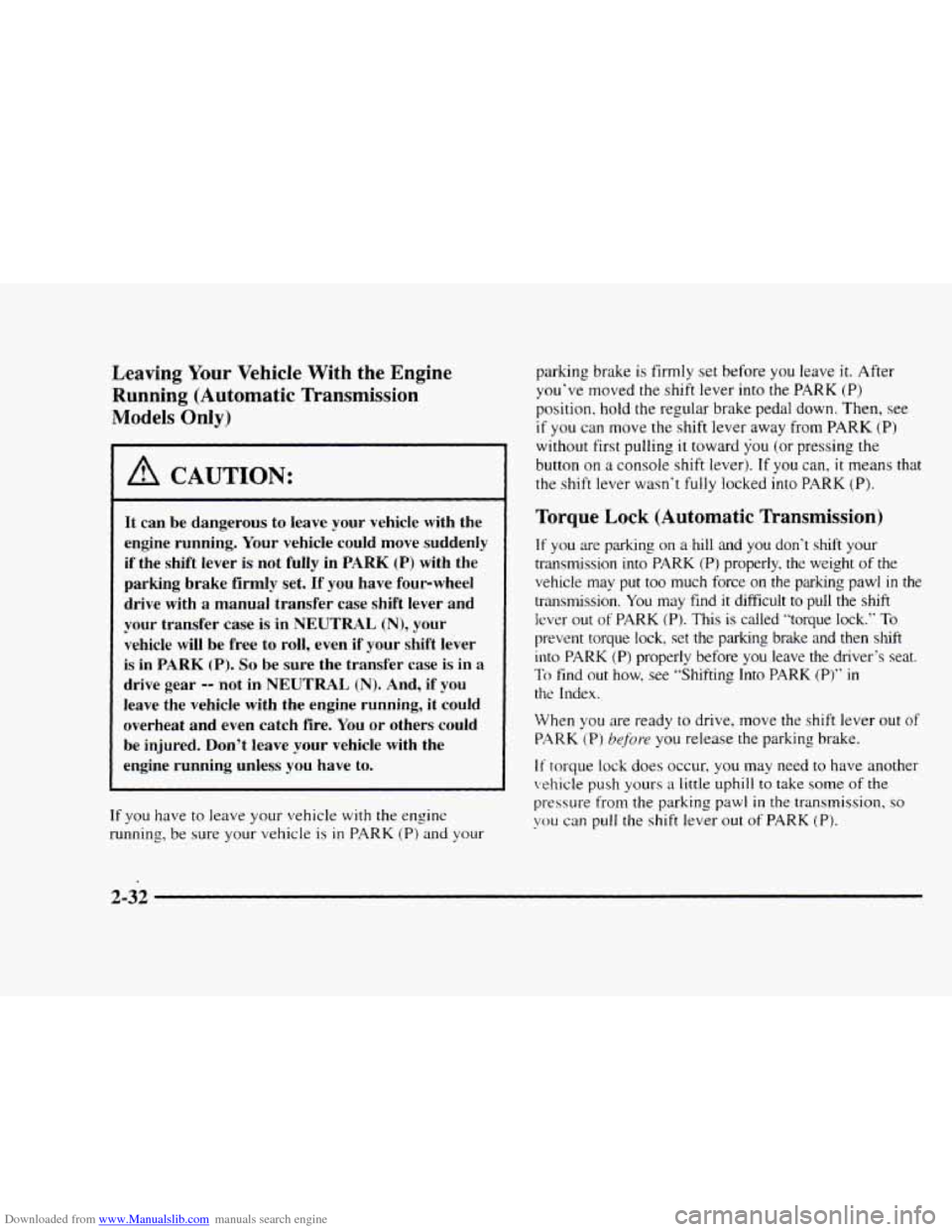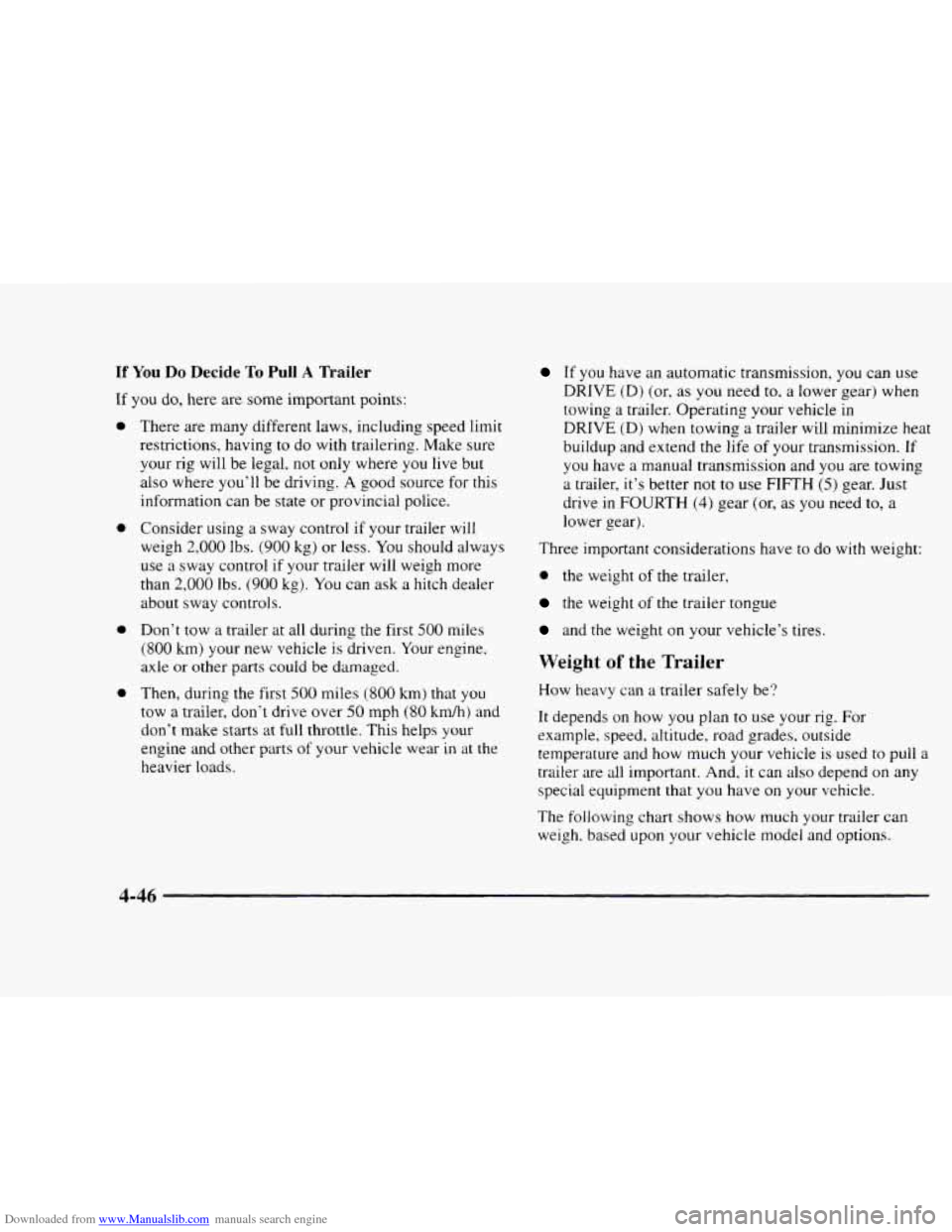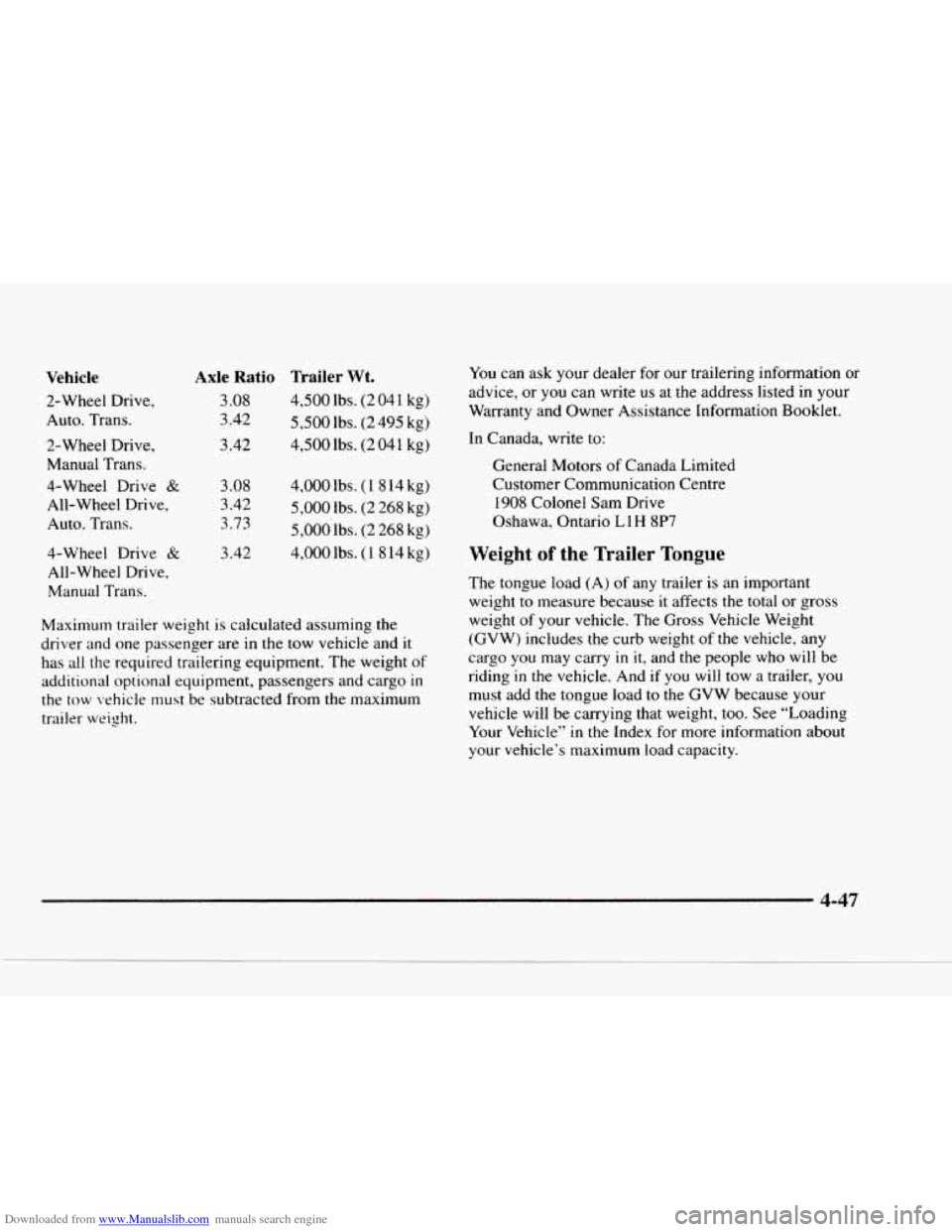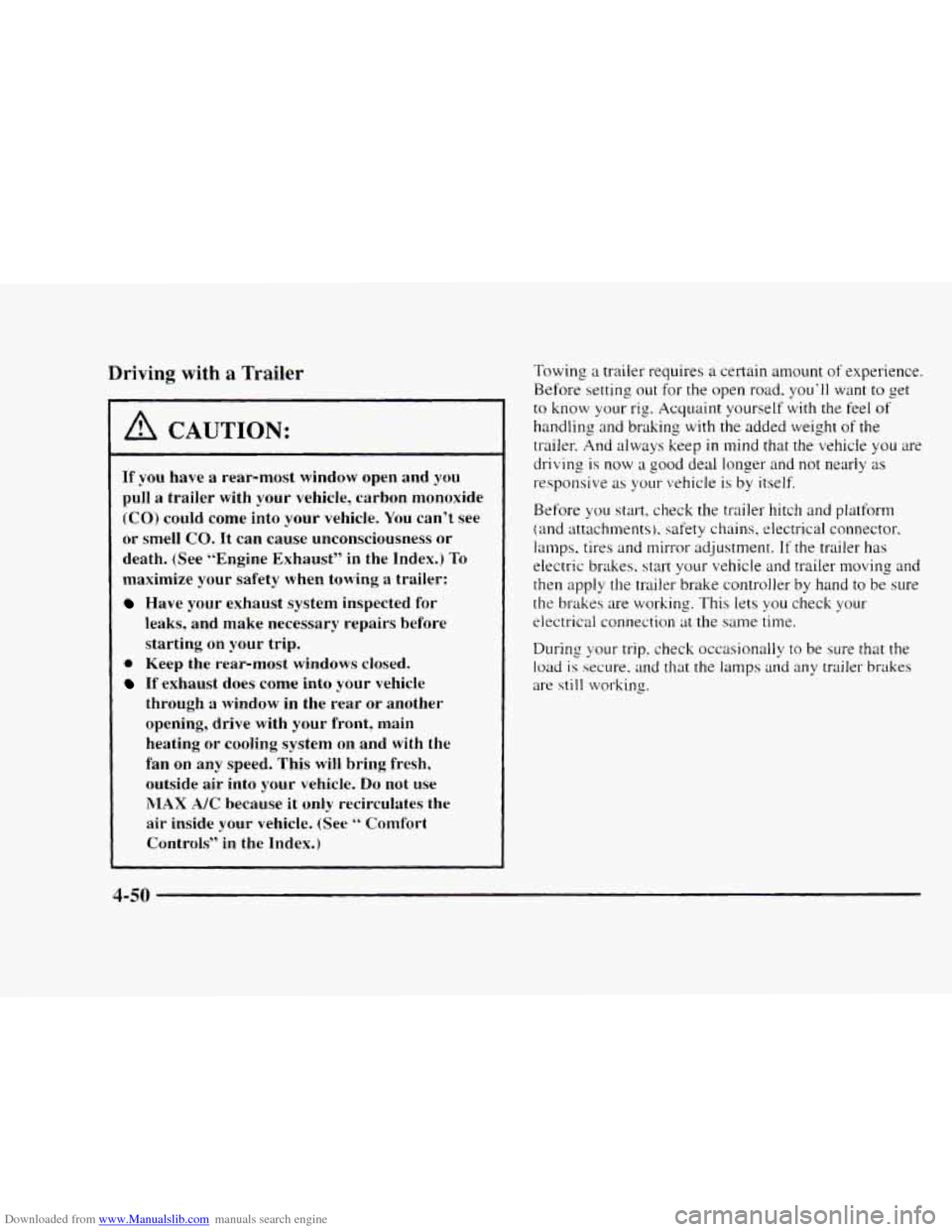1997 CHEVROLET BLAZER tow weight
[x] Cancel search: tow weightPage 89 of 402

Downloaded from www.Manualslib.com manuals search engine Leaving Your Vehicle With the Engine
Running (Automatic Transmission
Models Only)
I A CAUTION:
It can be dangerous to leave your vehicle with the
engine running. Your vehicle could move suddenly
if the shift lever is not fully in PARK (P) with the
parking brake firmly
set. If you have four-wheel
drive with
a manual transfer case shift lever and
your transfer case is in NEUTRAL (N), your
vehicle will
be free to roll, even if your shift lever
is in PARK (P). So be sure the transfer case is in a
drive gear -- not in NEUTRAL (N). And, if you
leave the vehicle with the engine running, it could
overheat and even catch fire. You or others could
be injured. Don't leave your vehicle with the
engine running unless you have to.
If you have to leave your vehicle with the engine
running, be sure your vehicle is
in PARK (P) and your parking brake
is firmly set before
you leave it. After
you've moved the shift lever into the
PARK (P)
position, hold the regular brake pedal down. Then, see
if you can move the shift lever away from PARK (P)
without first pulling it toward you (or pressing the
button
on a console shift lever). If you can, it means that
the shift lever wasn't
fully locked into PARK (P).
Torque Lock (Automatic Transmission)
If you are parking on a hill and you don't shift your
transmission
into PARK (PI properly, the weight of the
vehicle may
put too much force on the parlung pawl in the
tr'msmission.
You may find it difficult to pull the shift
Icver out of PARK (P). This is called "torque lock." To
prevent torque lock, set the parking brake and then shift
into
PARK (P) properly before you leave the driver's seat.
To find out how, see "Shifting Into PARK (P)" in
the Index.
When you are ready to drive, move the shift lever out
of
PARK (P) before you release the parking brake.
If torque lock does occur. you may need to have another
vehicle push yours a little uphill
to take some of the
pressure from the parking pawl
in the transmission, so
you can pull the shift lever out of PARK (P).
2-32
Page 203 of 402

Downloaded from www.Manualslib.com manuals search engine Recreational Vehicle Towing (Except Four-wheel Drive
With
Manual Shift Transfer Case) Loading
Your Vehicle
Vehicles
with two-wheel drive or the optional electronic
shift transfer case require special modifications before
they can be towed in this manner. Please contact your
dealer
for the towing information that is appropriate for
your particular vehicle.
Vehicles with all-wheel drive
(AWD) can not be towed
in this manner.
The Certificationflire label is found on the driver’s door
edge, above the
door latch. The label shows the size of
your original tires and the inflation pressures needed to
obtain the gross weight capacity of your vehicle. This is
called the
GVWR (Gross Vehicle Weight Rating). The
GVWR includes the weight of the vehicle. all occupants,
fuel, cargo and trailer tongue weight, if pulling a trailer.
4-42
Page 207 of 402

Downloaded from www.Manualslib.com manuals search engine If You Do Decide To Pull A Trailer
If you do, here are some important points:
a
a
a
a
There are many different laws, including speed limit
restrictions, having to do with trailering. Make sure
your rig
will be legal, not only where you live but
also where you’ll be driving.
A good source for this
information can be state or provincial police.
Consider using a sway control if your trailer
will
weigh 2,000 lbs. (900 kg) or less. You should always
use
a sway control if your trailer will weigh more
than
2,000 lbs. (900 kg). You can ask a hitch dealer
about sway controls.
Don’t tow a trailer at all during the first
500 miles
(800 km) your new vehicle is driven. Your engine,
axle
or other parts could be damaged.
Then, during the first
500 miles (800 km) that you
tow
a trailer, don‘t drive over 50 mph (80 kmh) and
don’t make starts
at full throttle. This helps your
engine and other parts
of your vehicle wear in at the
heavier loads.
If you have an automatic transmission, you can use
DRIVE
(D) (or. as you need to, a lower gear) when
towing
a trailer. Operating your vehicle in
DRIVE (D) when towing a trailer will minimize heat
buildup and extend the life
of your transmission. If
you have a manual transmission and you are towing
a trailer, it’s better not to use FIFTH (5) gear. Just
drive
in FOURTH (4) gear (or, as you need to, a
lower gear).
Three important considerations have
to do with weight:
0 the weight of the trailer,
the weight of the trailer tongue
and the weight on your vehicle’s tires.
Weight of the Trailer
How heavy can a trailer safely be?
It depends
on how you plan to use your rig. For
example, speed. altitude, road grades. outside
temperature and how much your vehicle
is used to pull a
trailer are all important. And, it can also depend on any
special equipment that
you have on your vehicle.
The following chart shows how much your trailer can
weigh, based upon your vehicle model and options.
4-46
Page 208 of 402

Downloaded from www.Manualslib.com manuals search engine Vehicle
2-Wheel Drive,
Auto. Trans.
2-Wheel Drive,
Manual Trans.
4-Wheel Drive
&
All-Wheel Drive,
Auto. Trans.
4-Wheel Drive
&
All-Wheel Drive, Manual Trans.
Axle Ratio Trailer Wt.
3 .OS 4,500 lbs. (2 04 1 kg)
3.42
5,500 lbs. (2 495 kg)
3.42 4,500 lbs. (2
04 1 kg)
3.08
3.42 3.73
3.42
4,000 lbs. (1 8 14 kg)
5,000 lbs. (2 268 kg)
5,000’1bs.
(2 268 kg)
4,000 lbs. (1 8 14 kg)
Maximum trailer weight is calculated assuming
the
driver and one passenger are in the tow vehicle and it
has all the required trailering equipment. The weight of
additional optional equipment, passengers and cargo in
the tow vehicle must be subtracted from the maximum
trailer weight. You
can ask your dealer for our trailering information or
advice, or you
can write us at the address listed in your
Warranty and Owner Assistance Information Booklet.
In Canada, write to:
General Motors
of Canada Limited
Customer Communication Centre
1908 Colonel Sam Drive
Oshawa, Ontario L
1 H 8P7
Weight of the Trailer Tongue
The tongue load (A) of any trailer is an important
weight to measure because it affects the total or gross
weight of your vehicle. The Gross Vehicle Weight
(GVW) includes the curb weight of the vehicle, any
cargo
you may carry in it, and the people who will be
riding in
the vehicle. And if you will tow a trailer, you
must add the tongue load to the GVW because your
vehicle will be carrying that weight, too. See “Loading
Your Vehicle”
in the Index for more information about
your vehicle’s maximum load capacity.
4-47
Page 211 of 402

Downloaded from www.Manualslib.com manuals search engine Driving with a Trailer
If you have a rear-most window open and you
pull a trailer with your vehicle, carbon monoxide
(CO) could come into your vehicle. You can’t see
or smell
CO. It can cause unconsciousness or
death. (See “Engine Exhaust” in the Index.)
To
maximize your safety when towing a trailer:
Have your exhaust system inspected for
leaks, and make necessary repairs before
starting on your trip.
0 Keep the rear-most windows closed.
If exhaust does come into your vehicle
through
a window in the rear or another
opening, drive with your front, main heating or cooling system on and
with the
fan on
any speed. This will bring fresh,
outside
air into your vehicle. Do not use
MAX A/C because it only recirculates the
air inside your vehicle. (See b‘ Comfort
Controls”
in the Index.) Towing
a trailer requires a certain
amount of experience.
Before setting out for the open road. you‘ll want
to get
to know your rig. Acquaint yourself with the feel of
handling and braking with the added weight of the
trailer. And always keep in mind that the vehicle you are
driving
is now a good deal longer and not nearly as
responsive as your vehicle is by itself.
Before
you start, check the trailer hitch and platform
(and attachments). safety chains. electrical connector,
lamps, tires and mirror adjustment. If the trailer has
electric brakes. start your vehicle and trailer moving and
then apply the trailer brake controller by hand to be sure
the brakes are working. This lets
you check your
electrical connection at the same time.
During your trip. check occasionally to be sure that the
load is secure. and that the lamps and any trailer brakes
are still working.
4-50
Page 399 of 402

Downloaded from www.Manualslib.com manuals search engine Theft ......................................... 2-12
THEFTLOCK
TI( ............................... 3-17
Thermostat
.................................... 6-26
Third Gear. Manual Transmission
.................. 2-2 1
Tilt Steering Wheel ............................. 2-38
Time. Setting
................................... 3-6
Tire Chains
.................................... 6-48
Tires Alignment and Balance
........................ 6-46
Changing a
Flat .............................. 5-23
Cleaning
.................................... 6-55
Inflation ............................... 6-41. 7-46
Inspection and Rotation
........................ 6-42
Pressure
.................................... 6-41
Temperature
................................. 6-46
Traction
.................................... 6-46
Treadwear
................................... 6-45
Uniform Quality Grading
....................... 6-45
Wear Indicators
.................. : ........... 6-44
When It’s Time for New
....................... 6-44
TopStrap
..................................... 1-38
TorqueLock
................................... 2-32
BuyingNew
................................. 6-44
Torque, Wheel
Nut ......................... 5-32, 6-63
Towing
a Trailer ................................ 4-45
Towing, Recreational Vehicle
..................... 3-41
Towing Your Vehicle
............................. 5-7
Brakes ................................... 4-49
Trailer Driving on
Grades
............................ 4-52
Driving
with a Trailer .......................... 4-50
Hitches
..................................... 4-48
Maintenance When Towing
..................... 4-54
Parking on Hills
.............................. 4-52
Safety Chains
................................ 4-49
Tongueweight
............................... 4-47
Total Weight on Tires
.......................... 4-48
Towing
..................................... 4-45
Turn Signals
................................. 4-51
Weight ..................................... 4-46
Wiring Harness
............................... 4-55
Transfer Case
.................................. 6-21
Electronic
................................... 2-26
Manual
..................................... 2-24
Automatic
................................... 6-14
Manual
..................................... 6-18
Transmitters
. Keyless Entry ........................ 2-6
Transportation. Courtesy .......................... 8-8
Trip. Before Leaving ............................ 3-34
TTYUsers
..................................... 8-4
Turn Signal and Lane Change Signals
............... 2-39
Turn Signals When Towing
a Trailer ................ 4-51
Transmission Fluid
Trip Odometer
................................. 2-71
Underbody Maintenance ........................ 6-56
Underhood Lamp Bulb Replacement ................ 6-37
9-10